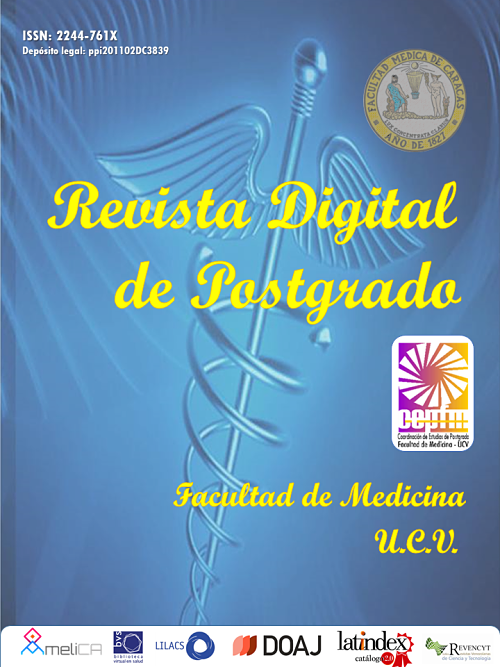Listeria monocytogenes and Trojan horse mechanism across the blood-brain barrier
DOI:
https://doi.org/10.37910/RDP.2024.13.1.e389Keywords:
Listeria monocytogenes, Monocitos, Macrófagos, Quimiotaxis, Barrera HematoencefálicaAbstract
Central nervous system infections are life- threatening, caused by pathogens such as bacteria, viruses and fungi. To access the brain, microorganisms use
various mechanisms. Listeria monocytogenes is a short, flagellar and intracellular gram-positive bacterium, with the ability to induce its internalization in phagocytic (monocytes/macrophages) and non-phagocytic (endothelial cells) cells. By infecting macrophages, these microorganisms take advantage of their binding, adhesion, and transendothelial migration capacity to cross the blood-brain barrier, finally generating bacterial meningitis. In this review we describe the Trojan horse mechanism used by Listeria monocytogenes to invade the brain in the development of infectious diseases and we incorporate new knowledge about molecules that intervene in this mechanism.
Downloads
References
Le Govic Y, Demey B, Cassereau J, Bahn YS, Papon N. Pathogens infecting the central nervous system.PLoS Pathog. 2022; 18(2): e1010234.
Subbarao S, Ribeiro S, Campbell H, Okike I, Ramsay ME, Ladhani SN. Trends in laboratory-confirmed bacterial meningitis (2012-2019): national observational study, England. Lancet Reg Health Eur. 2023; 32:100692.
Koelman DLH, van Kassel MN, Bijlsma MW, Brouwer MC, van de Beek D, van der Ende A. Changing Epidemiology of Bacterial Meningitis Since Introduction of Conjugate Vaccines: 3 Decades of National Meningitis Surveillance in The Netherlands. Clin Infect Dis. 2021; 73(5): e1099- e1107.
Hasbun R. Progress and Challenges in Bacterial Meningitis: A Review. JAMA. 2022; 328(21): 2147-2154.5. Costa BKD, Sato DK. Viral encephalitis: a practical review on diagnostic approach and treatment. J Pediatr (Rio J). 2020; 96(Suppl 1): 12-19.
Santiago FH, Onken MD, Cooper JA, Klein RS, Doering TL. Trojan Horse Transit Contributes to Blood- Brain Barrier Crossing of a Eukaryotic Pathogen. mBio. 2017; 8(1): e02183-16.
Echezuría L, León R, Rodríguez E, Rísquez A. Epidemiología de la meningitis en Venezuela 2010. Archivos Venezolanos de Puericultura y Pediatría. 2010; 73(4): 29-36.
Li Z, Bruno VM, Kim KS. Central Nervous System-Infecting Pathogens Escherichia coli and Cryptococcus neoformans Exploit the Host Pdlim2 for Intracellular Traversal and Exocytosis in the Blood-Brain Barrier. Infect Immun. 2021; 89(10): e0012821.
Julian J, Robiatul A, Sri W. Biomolecular activity of Cryptococcus during Cryoticiccisus: A review of molecular intereactions of Cryptococcus with human immune system and Blod-Brain-Barriet. Afr J Infect Dis. 2023; 18(1):11-22.
Kaya M, Ahishali B. Basic physiology of the blood-brain barrier in health and disease: a brief overview. Tissue Barriers. 2021; 9(1):1840913.
Wu D, Chen Q, Chen X, Han F, Chen Z, Wang Y. The blood-brain barrier: structure, regulation, and drug delivery. Signal Transduct Target Ther. 2023; 8(1): 217.
Kadry H, Noorani B, Cucullo L. A blood-brain barrier overview on structure, function, impairment, and biomarkers of integrity. Fluids Barriers CNS. 2020; 17(1): 69.
Zhao Y, Gan L, Ren L, Lin Y, Ma C, Lin X. Factors influencing the blood-brain barrier permeability. Brain Res. 2022; 1788: 147937.
Marchetti L, Engelhardt B. Immune cell trafficking across the blood-brain barrier in the absence and presence of neuroinflammation. Vasc Biol. 2020; 2(1): H1-H18.
Kim KS. Mechanisms of microbial traversal of the blood-brain barrier. Nat Rev Microbiol. 2008; 6(8): 625-634.
Shahid AD, Lu Y, Iqbal MA, Lin L, Huang S, Jiang X, Chen S. Listeria monocytogenes crosses blood brain barrier through Rho GTPases induced migration of macrophages and inflammatory interleukin expression. Microb Pathog. 2021; 159: 105143.
Sibanda T, Buys EM. Listeria monocytogenes Pathogenesis: The Role of Stress Adaptation. Microorganisms. 2022; 10(8): 1522.
Eitel J, Suttorp N, Opitz B. Innate immune recognition and inflammasome activation in listeria monocytogenes infection. Front Microbiol. 2011; 1: 149.
Shen Y, Naujokas M, Park M, Ireton K. InIB-dependent internalization of Listeria is mediated by the Met receptor tyrosine kinase. Cell. 2000; 103(3): 501-510.
Galea I. The blood-brain barrier in systemic infection and inflammation. Cell Mol Immunol. 2021; (11): 2489-2501.
Ivan DC, Walthert S, Locatelli G. Monocyte recruitment to the inflamed central nervous system: migration pathways and distinct functional polarization. BioRxiv. (2020): 2020-04.
Denes A, Hansen CE, Oezorhan U, Figuerola S, de Vries HE, Sorokin L, et al. Endothelial cells and macrophages as allies in the healthy and diseased brain. Acta Neuropathol. 2024; 147(1): 38.
Qiu YM, Zhang CL, Chen AQ, Wang HL, Zhou YF, Li YN, Hu B. Immune Cells in the BBB Disruption After Acute Ischemic Stroke: Targets for Immune Therapy? Front Immunol. 2021; 12: 678744
Downloads
Published
How to Cite
Issue
Section
License
Copyright (c) 2024 Ramón Andrade Pineda, Andrés Duque Prieto

This work is licensed under a Creative Commons Attribution 4.0 International License.
Usted es libre de:
- Compartir — copiar y redistribuir el material en cualquier medio o formato
- Adaptar — remezclar, transformar y construir a partir del material
- para cualquier propósito, incluso comercialmente.
Bajo los siguientes términos:
-
Atribución — Usted debe dar crédito de manera adecuada, brindar un enlace a la licencia, e indicar si se han realizado cambios. Puede hacerlo en cualquier forma razonable, pero no de forma tal que sugiera que usted o su uso tienen el apoyo de la licenciante.
- No hay restricciones adicionales — No puede aplicar términos legales ni medidas tecnológicas que restrinjan legalmente a otras a hacer cualquier uso permitido por la licencia.











